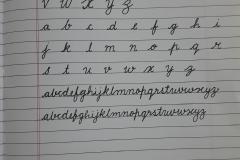Role and Responsibilities:
In my role as a handwriting instructor, I have worked with students across different age groups, from early learners to adults, helping them develop clear, legible, and aesthetically pleasing handwriting. My responsibilities included:
-
Assessment of Handwriting Skills: Evaluating each student’s handwriting to identify areas that needed improvement. This involved analyzing aspects such as letter formation, spacing, alignment, grip, and writing speed.
-
Developing Customized Programs: Creating individualized handwriting programs tailored to the specific needs of each student. These programs focused on improving fine motor skills, pencil grip, and letter formation, and were adjusted based on the student’s progress.
-
Teaching Basic Handwriting Techniques: Instructing students on the fundamentals of handwriting, including:
- Proper Pencil Grip: Teaching the correct way to hold a pencil to ensure comfort and control. This involved working on fine motor skills and providing tools like pencil grips when necessary.
- Letter Formation: Demonstrating the correct way to form both uppercase and lowercase letters. I focused on teaching students to form letters from top to bottom and left to right, ensuring consistency in their writing.
- Spacing and Alignment: Guiding students on how to maintain proper spacing between words and letters, and how to keep their writing aligned with lines on paper. This was crucial for creating legible and organized text.
- Writing Posture: Instructing students on the importance of proper sitting posture while writing, including the placement of the paper and how to angle it for optimal writing comfort.
-
Progressive Skill Development:
- For Younger Students: Starting with basic letter tracing and gradually moving to freehand writing. I incorporated fun and engaging activities like writing in sand or using finger paint to make the learning process enjoyable.
- For Older Students: Focusing on refining cursive writing, improving writing speed, and enhancing the overall presentation of their handwriting. I also introduced more advanced concepts like calligraphy for those interested in decorative writing.
-
Use of Visual and Kinesthetic Learning Tools: Incorporating visual aids such as lined paper, handwriting worksheets, and letter templates, as well as kinesthetic activities like finger exercises and hand-strengthening games. These tools helped students develop the muscle memory necessary for fluent handwriting.
-
Encouraging Consistent Practice: Assigning daily or weekly handwriting exercises to reinforce what was taught in class. I emphasized the importance of regular practice to improve speed, accuracy, and legibility over time.
Key Achievements:
-
Improved Handwriting Clarity: Successfully helped students transform their handwriting from illegible or inconsistent to clear and neat. Many students who initially struggled with letter formation and spacing achieved significant improvements, leading to greater confidence in their writing abilities.
-
Enhanced Writing Speed and Fluency: For older students, particularly those in higher grades or adults, I focused on increasing writing speed without sacrificing legibility. This was particularly beneficial for students during exams or for professionals in their daily work.
-
Increased Student Confidence: Many students, especially those who had previously been self-conscious about their handwriting, gained confidence as their skills improved. This confidence translated into better performance in other areas, such as creative writing and note-taking.
-
Parental Involvement: Regularly communicated with parents, providing them with tips and resources to support their child’s handwriting practice at home. This collaboration often led to more rapid progress and sustained improvement.
Teaching Techniques:
-
Modeling and Imitation: Demonstrating proper handwriting techniques on the board or on worksheets, then having students imitate the motions. This method was particularly effective for younger students learning basic letter formation.
-
Repetition and Muscle Memory: Encouraging repeated practice of specific letters or words to build muscle memory. Over time, this repetition helped students write more fluidly and consistently.
-
Positive Reinforcement: Using praise and rewards to motivate students and reinforce good handwriting habits. I celebrated small successes, such as correctly forming a difficult letter or maintaining consistent spacing.
-
Adaptation to Learning Styles: Tailoring my approach to each student’s preferred learning style. For example, visual learners benefited from watching me write, while kinesthetic learners responded well to hands-on activities like tracing letters in sand or clay.
-
Integration with Other Subjects: Incorporating handwriting practice into other subjects like language arts and social studies. For instance, students would practice their handwriting by writing out spelling words, short essays, or historical facts, making the exercises more relevant and engaging.
Challenges and Solutions:
-
Challenge: Students with poor fine motor skills.
- Solution: Implementing specific exercises to strengthen hand muscles and improve dexterity. These included activities like using stress balls, cutting with scissors, and drawing shapes before writing letters.
-
Challenge: Students who were frustrated or disinterested in handwriting practice.
- Solution: Making the practice sessions more enjoyable by incorporating games, using colorful pens or pencils, and setting achievable goals to keep them motivated.
-
Challenge: Addressing bad handwriting habits in older students.
- Solution: Gradually correcting these habits by focusing on one aspect of handwriting at a time (e.g., grip, posture, letter formation) and providing targeted feedback to ensure long-term improvement.







